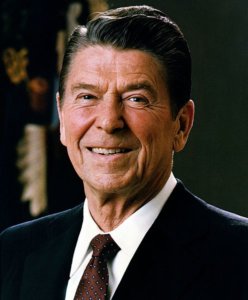

New Conservatism refers to the shift in the Republican Party that began in the 1960s and continued through the 1980s. New Conservatism is marked by a change in the Republican Party’s more moderate, centrist identity to a more extreme right-wing philosophy. To be successful on New Conservatism APUSH questions, it is important to know the key players in the rise of New Conservatism and to understand what these players were reacting against. For practice answering a document-based APUSH question about New Conservatism, try this DBQ released by the College Board.
New Conservatism marked a change in the Republican Party from the more moderate stance of President Eisenhower in the 1950s to a more extreme stance espousing small government, traditional values, constitutionalism, states-rights, and free-market economics. The rise of New Conservatism began with the politics of Barry Goldwater and the economics of Milton Friedman in the 1960s. Goldwater and Friedman reacted against Roosevelt’s New Deal programs, considering them to embody governmental overreach and to be the cause of deficits, inflation, and unemployment. Big government, they claimed, stifled states rights, individual liberties, and the economy.
These conservative political and economic views merged in the 1970s and ’80s with conservative social outlooks. The evangelical movement that arose at this time railed against the removal of prayer from public schools and pitted social progressivism against Christian morals. The Protestant work ethic was invoked to condemn welfare programs. Socialism, sexual liberation, and drug culture were seen as signs that the country had turned away from God.
White conservative Christians felt threatened by the social movements of the time: Civil Rights, feminism, and gay rights. Antiwar protests, militant black power groups, and Roe v. Wade convinced many Americans that the country was losing its traditional values. They saw New Conservatism as a way to return the country to its moral roots.
New Conservatism reformed the platform of the Republican Party, transforming it from a pro-business, laissez-faire party into one more concerned with individual liberties and traditional Christian morals. This shift gave the party a more populist face, allowing it to appeal to Southern whites who felt abandoned by the Democratic Party. New Conservatism paved the way for Ronald Reagan’s presidency, and its reverberations can be felt today in the rise of the Tea Party and Libertarian movements within the Republican Party.

“In this present crisis, government is not the solution to our problem; government is the problem. From time to time we’ve been tempted to believe that society has become too complex to be managed by self-rule, that government by an elite group is superior to government for, by, and of the people. Well, if no one among us is capable of governing himself, then who among us has the capacity to govern someone else? All of us together, in and out of government, must bear the burden. The solutions we seek must be equitable, with no one group singled out to pay a higher price.”
-First Inaugural Address of Ronald Reagan, 1981 (Source)
As reflected in this quote, the New Conservative movement that began in the 1960s and culminated with Reagan’s election was in large part a reaction against
A) the social welfare programs of the New Deal era.
B) the cost of Vietnam and other wars.
C) the spread of communism during the Cold War.
D) the corrupting influence of special interest groups.
The correct answer to this example New Conservatism APUSH question is (A). A major platform of the New Conservative movement was the advocacy for small government. New Conservatives believed that social welfare programs led to corruption, high taxation, and a stunted economy, as well as intrusions into the lives of ordinary Americans. Proponents of the free market and individual liberties, New Conservatives believed that social programs like those implemented during Roosevelt’s New Deal were egregious abuses of power by the federal government.
Sarah is an educator and writer with a Master’s degree in education from Syracuse University who has helped students succeed on standardized tests since 2008. She loves reading, theater, and chasing around her two kids. View all posts